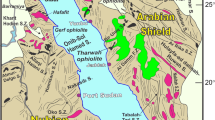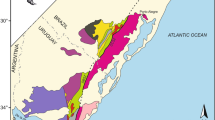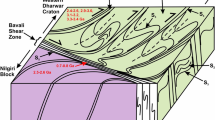Abstract
Mahanadi Shear Zone (MSZ) is located in the northern segment of the Eastern Ghats Mobile Belt (EGMB), represented by extensive mylonitization. WNW-trending mylonitic foliation has a moderate-to-steep dip towards NNE. Kinematic indicators such as asymmetric folds, shear bands, quarter structures, suggest dextral ductile shear sense of the dominant strike–slip component and reverse sense of the less prominent dip slip component. Predominance of foliation over lineation indicates flattening strain. Reverse movement and flattening strain confirm shortening. The MSZ is a transpressional zone with simple shear along and pure shear (shortening) perpendicular to the mylonitic fabric. Wide variation in plunge of stretching lineation, presence of back-rotated clasts and 0 < Wk < 1 on two sections oblique to the mylonitic foliation, suggest triclinic symmetry of deformation. This study demonstrates that the width of the MSZ—located in the northern part of the Phulbani Domain—extends beyond 38 km. It covers the entire ‘Tikarpara Domain’ in the north of Phulbani Domain and put the very existence of Tikarpara Domain in question. Lithounits of Phulbani Domain continue to the north across the southern boundary of the MSZ, through Tikarpara Domain and Angul Domain up to the Northern Boundary Shear Zone (NBSZ). It is proposed that the entire area comprising the Phulbani Domain, the MSZ, and the region further north up to the NBSZ, form part of a single domain—Phulbani Domain. MSZ is an outcome of intra-terrane transpression. Thus, this study also questions the credibility of the domainal classification of the EGMB.












Similar content being viewed by others
References
Alonso-Henar J, Fernández C, Martínez-Díaz JJ (2020) Application of the analytic model of general triclinic transpression with oblique extrusion to an active deformation zone: the Alhama de Murcia Fault (SE Iberian Peninsula). J Struct Geol 130:103924
Avé Lallemant HG (1997) Transpression, displacement partitioning, and exhumation in the eastern Caribbean-South American plate boundary zone. Tectonics, 16, 2, 272–289
Bally AW, Roberts DG, Sawyer D, Sinkewich A (2020) Chapter 27 - Tectonic and basin maps of the world. In: Regional geology and tectonics, pp 761–862. https://doi.org/10.1016/B978-0-444-64134-2.00026-2
Berthé D, Choukroune P, Gapais D (1979) Orthogneiss mylonite and non-coaxial deformation of granites: the example of the South Armorican shear zone. J Struct Geol 1:31–42
Bhattacharya S (1997) Evolution of Eastern Ghats granulite belt of India in a compressional tectonic regime and juxtaposition against Iron Ore Craton of Singhbhum by oblique–transpression. Proc Indian Acad Sci (Earth Planet Sci) 106(3):65–75
Bhattacharya S, Kar R, Misra S, Teixeira W (2001) Early Archaean continental crust in the Eastern Ghats granulite belt, India: isotopic evidence from a charnockite Suite. Geol Mag 138:609–618
Bhattacharya S, Kar R, Teixeira W, Basei M (2003) High-temperature crustal anatexis in a clockwise P-T path: isotopic evidence from a granulite-granitoid suite in the Eastern Ghats belt, India. J Geol Soc Lond 160:39–46
Biswal TK, De Waele B, Ahuja H (2007) Timing and dynamics of the juxtaposition of the Eastern Ghats Mobile Belt against the Bhandara Craton, India: a structural and zircon U-Pb SHRIMP study of the fold-thrust belt and associated nepheline syenite plutons. Tectonics. https://doi.org/10.1029/2006TC002005
Bo Z, JinJiang Z, DaLai Z, Lei G (2009) Strain and kinematic vorticity analysis: an indicator for sinistral transpressional strain-partitioning along the Lancangjiang shear zone, western Yunnan, China. Sci China Ser D Earth Sci 52(5):602–618
Bobyarchick A (1986) The eigenvalues of steady state flow in Mohr space. Tectonophysics 122:35–51
Bodorkos S, Clark DJ (2004) Evolution of a crustal-scale transpressive shear zone in the Albany-Fraser Orogen, SW Australia: 1. P–T conditions of Mesoproterozoic metamorphism in the Coramup Gneiss. J Metamorph Geol 22:691–711
Bose S, Gupta S (2018) Strain partitioning along the Mahanadi Shear Zone: implications for palaeotectonics of the Eastern Ghats Province, India. J Asian Earth Sci 157:269–282
Bose S, Gupta S (2020) Evolution of stretching lineations in granulite-hosted ductile shear zones, Eastern Ghats Province, India: role of temperature, strain rate and pre-existing stretching lineations. J Struct Geol 138:104–127
Bose S, Das K, Kimura K, Hidaka H, Dasgupta A, Ghosh G, Mukhopadhyay J (2016) Neoarchean tectonothermal imprints in the Rengali Province, eastern India and their implication on the growth of Singhbhum Craton: evidence from zircon U-Pb SHRIMP data. J Metamorph Geol 34(8):743–764
Bose S, Das A, Samantaray S, Banerjee S, Gupta S (2019) Late tectonic reorientation of lineaments and fabrics in the northern Eastern Ghats Province, India: evaluating the role of the Mahanadi Shear Zone. J Asian Earth Sci. https://doi.org/10.1016/j.jseaes.2019.104071
Braudy N, Gaschnig RM, Wilford D, Vervoort JD, Nelson CL, Davidson C, Kahn MJ, Tikoff B (2016) Timing and deformation conditions of the western Idaho shear zone, West Mountain, west-central Idaho. Lithosphere 9(2):157–183
Calais E, Mercier de Lepinay B (1991) From transtension to transpression along the northern Caribbean plate boundary off Cuba: implications for the Recent motion of the Caribbean plate. Tectonophysics 186:329–350
Cembrano J, Lavenu A, Reynolds P, Arancibia G, Lopez G, Sanhueza A (2002) Late Cenozoic transpressional ductile deformation north of the Nazca-South America–Antarctica triple junction. Tectonophysics 354:289–314
Cheeney RF (1983) Statistical methods in geology, chapter-9. George Allen and Unwin (Publishers) ltd., pp 107–127
Chetty TRK (2001) The Eastern Ghats Mobile Belt, India: a collage of juxtaposed terranes(?). Gondwana Res 4:319–328
Chetty TRK (2010) Structural architecture of the northern composite terrane, the Eastern Ghats Mobile Belt, India: implications for Gondwana tectonics. Gondwana Res 18:565–582
Chetty TRK (2014) Deep crustal Shear Zones in the Eastern Ghats Mobile Belt, India: Gondwana correlations. J Ind Geophys Union 18(1):19–56
Chetty TRK, Vijaya P, Narayana BL, Giridhar GV (2003) Structure of the Nagavali shear zone, Eastern Ghats Mobile Belt, India: correlation in the East Gondwana reconstruction. Gondwana Res 6:215–229
Czeck DM, Hudleston PJ (2003) Testing models for obliquely plunging lineations in transpression: a natural example and theoretical discussion. J Struct Geol 25:959–982
De Paor DG (1988) Rf/ϕf strain analysis using an orientation net. J Struct Geol 10(4):323–333
Díaz-Azpiroz M, Barcos L, Balanyá JC, Fernández C, Expósito I, Czeck DM (2014) Applying a general triclinic transpression model to highly partitioned brittle ductile shear zones: a case study from the Torcal de Antequera massif, external Betics, southern Spain. J Struct Geol 68:316–336. https://doi.org/10.1016/j.jsg.2014.05.010
Díaz-Azpiroz M, Fernández C, Czeck DM (2018) Are we studying deformed rocks in the right sections? Best practices in the kinematic analysis of 3D deformation zones. J Struct Geol 125:218–225
Dobmeier C and Raith MM (2003) Crustal architecture evolution of the Eastern Ghats Belt and adjacent regions of India. In: Yoshida M, Windley BF, Dasgupta S (eds) Proterozoic East Gondwana: supercontinent assembly and breakup, vol 206. Geol. Soc. London, Spec. Publ., pp 145–168
Draut AE, Clift PD (2001) Geochemical evolution of arc magmatism during arc-continent collision, South Mayo, Ireland. Geology 29(6):543–546
Dutta D, Mukherjee S (2021) Extrusion kinematics of UHP terrane in a collisional orogen: EBSD and microstructure-based approach from the Tso Morari Crystallines (Ladakh Himalaya). Tectonophysics. https://doi.org/10.1016/j.tecto.2020.228641
Dutton BJ (1997) Finite strains in transpression zones with no boundary slip. J Struct Geol 19:1189–1200
Fernández C, Díaz-Azpiroz M (2009) Triclinic transpression zones with inclined extrusion. J Struct Geol 31:1255–1269
Fernández C, Czeck DM, Díaz Azpiroz M (2013) Testing the model of oblique transpression with oblique extrusion in two natural cases: steps and consequences. J Struct Geol 54:85–102
Forte AM, Bailey CM (2007) Testing the utility of the porphyroclast hyperbolic distribution method of kinematic vorticity analysis. J Struct Geol 29:983–1001
Fossen H, Cavalcante GCG (2017) Shear zones—a review. Earth Sci Rev 171:434–455
Fossen H, Tikoff B (1993) The deformation matrix for simultaneous simple shearing, pure shearing and volume change, and its application to transpression-transtension tectonics. J Struct Geol 15:413–422
Fossen H, Tikoff B (1998) Extended models of transpression and transtension, and application to tectonic settings. In: Holdsworth RE, Strachan RA, Dewey JE (eds) Continental transpressional and transtensional tectonics, vol 135. Geological Society, London, Special Publications, pp 15–33
Fossen H, Tikoff B, Teyssier C (1994) Strain modelling of transpressional and transtensional deformation. Nor Geol Tidsskr 74:134–145
Frassi C, Carosi R, Montomoli C, Law RD (2009) Kinematics and vorticity of flow associated with post-collisional oblique transpression in the Variscan Inner Zone of northern Sardinia (Italy). J Struct Geol 31:1458–1471
Gerald JDF, Mancktelow NS, Pennacchioni G, Kunze K (2006) Ultrafine-grained quartz mylonites from high-grade shear zones: evidence for strong dry middle to lower crust. Geology 34(5):369–372
Ghosh SK, Ramberg H (1976) Reorientation of inclusions by combination of pure shear and simple shear. Tectonophysics 34:1–70
Giorgis S, Michels Z, Dair L, Braudy N, Tikoff B (2016) Kinematic and vorticity analyses of the western Idaho shear zone, USA. Lithosphere 9(2):223–234
Goodwin LB, Williams PF (1996) Deformation path partitioning within a transpressive shear zone, Marble Cove, Newfoundland. J Struct Geol 18:975–990
Greene DC, Schweickert RA (1995) The Gem Lake shear zone: cretaceous dextral transpression in the northern Ritter Range pendant, eastern Sierra Nevada, California. Tectonics 14:945–961
Hanmer S, Passchier CW (1991) Shear-sense indicators: a review. Geol Surv Can Pap 90–17:72
Harland WB (1971) Tectonic transpression in Caledonian Spitsbergen. Geol Mag 108:27–42
Huddleston PJ, Schultz-Ela D, Southwick DL (1988) Transpression in an Archean greenstone belt, northern Minnesota. Can J Earth Sci 25:1060–1068
Jiang D, Williams PF (1998) High strain zones: a unified model. J Struct Geol 20:1105–1120
Jones RR, Holdsworth RE, Clegg P, McCaffrey K, Tavarnelli E (2004) Inclined transpression. J Struct Geol 26:1531–1548
Kovach VP, Simmat R, Rickers K, Berezhnaya NG, Salnikova EB, Dobmeier C, Raith MM, Yakovleva SZ, Kotov AB (2001) The Western Charnockite Zone of the Eastern Ghats Belt, India; an independent crustal province of late Archaean (2.8 Ga) and Paleoproterozoic (1.7–1.6 Ga) terrains. Gondwana Res 4:666–667
Kuiper YD, Lin S, Jiang D (2011) Deformation partitioning in transpressional shear zones with an along-strike stretch component: an example from the Superior Boundary Zone, Manitoba, Canada. J Struct Geol 33:192–202
Lin S, Jiang D, Williams PF (1998) Transpression (or transtension) zones of triclinic symmetry: natural example and theoretical modelling. Geol Soc Lond Spec Publ 135:41–57
Mahapatro SN, Tripathy AK, Nanda JK, Abhinaba R (2009) Co-existing ultramylonite and pseudotachylite from the eastern segment of the Mahanadi Shear Zone, Eastern Ghats Mobile Belt. J Geol Soc India 74:679–689
Mainprice D, Bascou J, Cordier P, Tommasi A (2004) Crystal preferred orientations of garnet: comparison between numerical simulations and electron back-scattered diffraction (EBSD) measurements in naturally deformed eclogites. J Struct Geol 26:2089–2102
Meghraoui M, Pondrelli S (2012) Active faulting and transpression tectonics along the plate boundary in North Africa. Ann Geophys 55:5. https://doi.org/10.4401/ag-4970
Mishra SN, Udhoji SG (1970) Report on the systematic mapping in parts of Phulbani district, Orissa. GSI report, F.S. 1969–70
Mohajjel M, Fergusson CL (2000) Dextral transpression in Late Cretaceous continental collision, Sanandaj-Sirjan Zone, western Iran. J Struct Geol 22:1125–1139
Moharana T, Ghosh A (2014) Report on specialised thematic mapping of the terrain south of Mahanadi graben in Takara-Dashapalla-Arhakata segment of Eastern Ghats mobile belt in central Odisha to understand the Precambrian evolution of the Mahanadi Tectonic Zone (MTZ). GSI report, F.S. 2013–14
Morel JL, Meghraoui M (1996) Goringe-Alboran-Tell tectonic zone: a transpression system along the Africa-Eurasia plate boundary. Geology 24(8):755–758
Mukherjee S, Punekar J, Mahadani T, Mukherjee R (2015) A review on intrafolial folds and their morphologies from the detachments of the western Indian Higher Himalaya. In: Mukherjee S, Mulchrone KF (eds) Ductile shear zones: from micro- to macro-scales. W. Blackwell, pp 182–205 (ISBN: 978-1-118-84496-0)
Mukhopadhyay D, Basak K (2009) The Eastern Ghats Belt–a polycyclic granulite terrain. J Geol Soc India 73:489–518
Nabavi ST, Díaz-Azpiroz M, Talbot CJ (2016) Inclined transpression in the Neka Valley, eastern Alborz, Iran. Int J Earth Sci (Geol Rundsch). https://doi.org/10.1007/s00531-016-1388-y
Nash CR, Rankin LR, Leeming PM, Harris LB (1996) Delineation of lithostructural domains in northern Orissa (India) from Landsat Thematic Mapper imagery. Tectonophysics 260:245–257
Oldow JS, Bally AW, Ave Lallement HG (1990) Transpression, orogenic float, and lithospheric balance. Geology 18:991–994
Passchier CW (1997) The fabric attractor. J Struct Geol 19:113–127
Passchier CW (1998) Monoclinic model shear zones. J Struct Geol 20(8):1121–1137
Passchier CW, Coelho S (2006) An outline of shear-sense analysis in high-grade rocks. Gondwana Res 10:66–76
Passchier CW, Trouw RAJ (2005) Microtectonics. Springer, Berlin
Ramakrishnan M, Nanda JK, Augustine PF (1998) Geological evolution of the Proterozoic Eastern Ghats Mobile Belt. Geol Surv India Spec Publ 44:1–21
Rickers K, Mezger K, Raith MM (2001) Evolution of the continental crust in the Proterozoic Eastern Ghats Belt, India and new constraints for Rodinia reconstruction: implications from Sm-Nd, Rb-Sr and Pb-Pb isotopes. Precambrian Res 112:183–210
Robin P-YF, Cruden AR (1994) Strain and vorticity patterns in ideally ductile transpression zones. J Struct Geol 16:447–466
Rohr KMM, Scheidhauer M, Trehu AM (2000) Transpression between two warm mafic plates: The Queen Charlotte Fault revisited. J Geophys Res 105(B4):8147–8172
Roy Chowdhury S, Choudhary RK (1965) Report on the systematic mapping in parts of Phulbani district, Orissa. GSI Report, F.S. 1963–64
Sanderson D, Marchini RD (1984) Transpression. J Struct Geol 6:449–458
Sarkar M, Gupta S, Panigrahi MK (2007) Disentangling tectonic cycles along a multiply deformed terrane margin: Structural and metamorphic evidence for mid-crustal reworking of the Angul granulite complex, Eastern Ghats Belt, India. J Struct Geol 29:802–818
Sengupta S, Ramachandra HM, Roy A (2020) Ductile shear zones along the margins of Neoarchaean Chitradurga Schist Belt with particular reference to tectonic status of Ghattihosahalli Belt of Dharwar Craton, India. Indian J Geosci 74(3):295–306
Seth BK (1963) Report on the systematic mapping carried out in parts of Phulbani district, Orissa. GSI report, F.S. 1962–63
Simpson C, De Paor DG (1993) Strain and kinematic analysis in general shear zones. J Struct Geol 15:1–20
Simpson C, De Paor DG (1997) Practical analysis of general shear zones using the porphyroclast hyperbolic distribution method: an example from the Scandinavian Caledonides In: Sengupta S (ed) Evolution of geological structures in micro- to macro-scales. Chapman and Hall, pp 169–184
Simpson C, Schmid S (1983) An evaluation of shear criteria to deduce the sense of movements in sheared rocks. Geol Soc Am Bull 94:1281–1288
Stephan T, Kroner U, Hahn T, Hallas P, Heuse T (2016) Fold/cleavage relationships as indicator for late Variscan sinistral transpression at the Rheno-Hercynian–Saxo-Thuringian boundary zone, Central European Variscides. Tectonophysics 681:250–262
Storey CD, Prior DJ (2005) Plastic deformation and recrystallization of garnet: a mechanism to facilitate diffusion creep. J Petrol 46(12):2593–2613
Sullivan WA, Beane RJ, Beck EN, Fereday WH, Roberts-Pierel AM (2011) Testing the Transpression hypothesis in the western part of the Cheyenne belt, Medicine Bow Mountains, southeastern Wyoming. Rocky Mt Geol 46(2):111–135
Teyssier C, Tikoff B, Markley M (1995) Oblique plate motion and continental tectonics. Geology 23:447–450
Tikoff B, Fossen H (1995) The limitations of three-dimensional kinematic vorticity analysis. J Struct Geol 17:1771–1784
Tikoff B, Greene D (1997) Stretching lineations in transpressional shear zones. J Struct Geol 19:29–40
Toy VG, Prior DJ, Norris RJ, Cooper AF (2012) Relationships between kinematic indicators and strain during syn-deformational exhumation of an oblique slip, transpressive, plate boundary shear zone: the Alpine Fault, New Zealand. Earth Planet Sci Lett. https://doi.org/10.1016/j.epsl.2012.04.037
Trouw RAJ, Passchier CW, Wiersma DJ (2010) Atlas of mylonite and related microstructures. Springer, Berlin
Voegelé V, Cordier P, Sautter V, Sharp TG, Lardeaux JM, Marques FO (1998) Plastic deformation of silicate garnets. II. Deformation microstructures in natural samples. Phys Earth Planet Inter 108(4):319–338
Wang ZC, Ji S (1999) Deformation of silicate garnets: brittle-ductile transition and its geological implications. Can Mineral 37:525–541
Whitmeyer SJ, Simpson C (2003) High strain-rate deformation fabrics characterize a kilometres-thick Palaeozoic fault zone in the Eastern Sierras Pampeanas, central Argentina. J Struct Geol 25:909–922
Woodcock NH (1977) Specification of fabric shapes using an eigenvalue method. Geol Soc Am Bull 88(9):1231–1236
Xypolias P (2010) Vorticity analysis in shear zones: a review of methods and applications. J Struct Geol 32:2072–2092
Acknowledgements
We are thankful to the Director General, Geological Survey of India, for providing opportunity for the research work and permission for publication of this paper. We express our gratitude to Dr. Abhinaba Roy for his technical suggestions in various stages of this work as and when required. Shri. P. K. Mohanty, Shri. Basab Chattopadhyay and Dr. Subrata Chakraborti are thanked for providing administrative support in the laboratory studies and logistic support during field work. The first author received assistance from Shri. J. K. Nanda and Dr. S. Bhattacharya during field work and from Dr. Kasturi Chakraborty in petrographic studies in many occasions. We are also thankful to Shri. S. N. Mahapatro for reviewing the manuscript during internal review process of Geological Survey of India. Kind co-operation of colleagues of the first author in Central Petrological Laboratories, Geological Survey of India, Kolkata, is also acknowledged. The unknown reviewers, Dr. Soumyajit Mukherjee and Dr. M. Díaz Azpiroz are duly acknowledged for their constructive comments on the manuscript which have immensely helped us to improve it further.
Author information
Authors and Affiliations
Contributions
All authors contributed to the study conception and design. Material preparation, data collection and analysis were performed by Arya Ghosh and Tapan Moharana. The first draft of the manuscript was written by Arya Ghosh and all authors commented on previous versions of the manuscript. All authors read and approved the final manuscript. CRediT taxonomy: Conceptualization: Arya Ghosh, Tapas Bhattacharyya, Rajib Kar; methodology: Arya Ghosh, Tapas Bhattacharyya, Rajib Kar; formal analysis and investigation: Arya Ghosh and Tapan Moharana, writing—original draft preparation: Arya Ghosh; writing—review and editing: Tapas Bhattacharyya, Rajib Kar; supervision: Tapas Bhattacharyya, Rajib Kar.
Corresponding author
Supplementary Information
Below is the link to the electronic supplementary material.
Rights and permissions
About this article
Cite this article
Ghosh, A., Bhattacharyya, T., Kar, R. et al. Structural framework of the transpressive Mahanadi Shear Zone and reevaluation of the regional geology in the northern sector of the Eastern Ghats Mobile Belt, Eastern India. Int J Earth Sci (Geol Rundsch) 110, 1631–1652 (2021). https://doi.org/10.1007/s00531-021-02034-8
Received:
Accepted:
Published:
Issue Date:
DOI: https://doi.org/10.1007/s00531-021-02034-8




